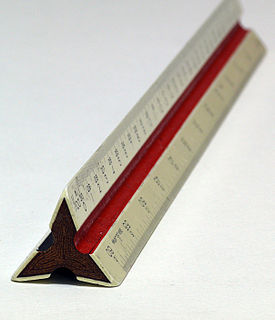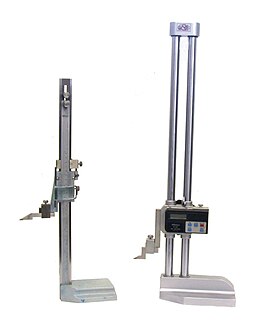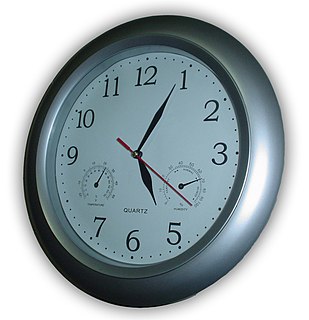
A ruler, sometimes called a rule, line gauge, or scale, is a device used in geometry and technical drawing, as well as the engineering and construction industries, to measure distances or draw straight lines.

A straightedge or straight edge is a tool used for drawing straight lines, or checking their straightness. If it has equally spaced markings along its length, it is usually called a ruler.

Marking blue or layout stain is a dye used in metalworking to aid in marking out rough parts for further machining. It is used to stain or paint a metal object with a very thin layer of dye that can be scratched off using a scriber or other sharp instrument to reveal a bright, yet very narrow line in the metal underneath. The advantages are that any existing scratches are covered with the dye and the new lines have a contrasting background.

A scale model is a physical model which is geometrically similar to an object. Scale models are generally smaller than large prototypes such as vehicles, buildings, or people; but may be larger than small prototypes such as anatomical structures or subatomic particles. Models built to the same scale as the prototype are called mockups.

A combination square is a multi-purpose measuring and marking tool used in metalworking, woodworking, and stonemasonry. It is composed of a rule and one or more interchangeable heads that can be attached to the rule. Other names for the tool include adjustable square, combo square, and sliding square.

A try square or try-square is a woodworking tool used for marking and checking 90° angles on pieces of wood. Though woodworkers use many different types of square, the try square is considered one of the essential tools for woodworking.

A height gauge is a measuring device used for determining the height of objects, and for marking of items to be worked on.

A scriber is a hand tool used in metal work to mark lines on workpieces, prior to machining. The process of using a scriber is called scribing and is just part of the process of marking out. It is used instead of pencils or ink lines, because the latter are hard to see, easily erased, and imprecise due to their wide mark; scribe lines are thin and semi-permanent. On non-coated workpieces marking blue is commonly used to increase the contrast of the mark lines.
Marking out or layout means the process of transferring a design or pattern to a workpiece, as the first step in the manufacturing process. It is performed in many industries or hobbies although in the repetition industries the machine's initial setup is designed to remove the need to mark out every individual piece.

A dial is generally a flat surface, circular or rectangular, with numbers or similar markings on it, used for displaying the setting or output of a timepiece, radio, clock, watch, or measuring instrument. There are many instruments used in scientific and industrial applications that use dials with pointers as indicators of a specific physical property. Typical examples include pressure and vacuum gauges, fluid-level gauges, voltmeters and ammeters, thermometers and hygrometers, speedometers and tachometers, and indicators.

A marking gauge, also known as a scratch gauge, is used in woodworking and metalworking to mark out lines for cutting or other operations. The purpose of the gauge is to scribe a line parallel to a reference edge or surface. It is used in joinery and sheetmetal operations.

A wiggler, also known as a wobbler, edge-finder, center-finder or laser-centering-device, is a tool used with a machine like a mill, to accurately align the machine head with the work prior to machining.
Metalworking hand tools are hand tools that are used in the metalworking field. Hand tools are powered solely by the operator.

A marking knife or striking knife is a woodworking layout tool used for accurately marking workpieces. It is used to cut a visible line, which can then be used to guide a hand saw, chisel or plane when making woodworking joints and other operations. They are generally used when marking across the grain of the wood, with scratch awls better suited for marking with the grain.

A scratch awl is a woodworking layout and point-making tool. It is used to scribe a line to be followed by a hand saw or chisel when making woodworking joints and other operations.
Lofting is a drafting technique to generate curved lines. It is used in plans for streamlined objects such as aircraft and boats. The lines may be drawn on wood and the wood then cut for advanced woodworking. The technique can be as simple as bending a flexible object, such as a long strip of thin wood or thin plastic so that it passes over three non-linear points, and scribing the resultant curved line; or as elaborate as plotting the line using computers or mathematical tables.

A fence is a part of many woodworking tools, they are typically used to guide or secure a workpiece while it is being sawn, planed, routed or marked. Fences play an important role for both accuracy and safety. Fences are usually straight and vertical, and made from metal, wood or plastic.

The Stanley No. 1 Odd Jobs was a tool produced by the Stanley Works from 1888 to the 1930s. It combined features of sundry tools, in a single pocketable tool, including:

A mortise gauge or mortice gauge is a woodworking tool used by a carpenter or joiner to scribe mortise and tenon joints on wood prior to cutting. Mortise gauges are commonly made of hardwood with brass fittings.















